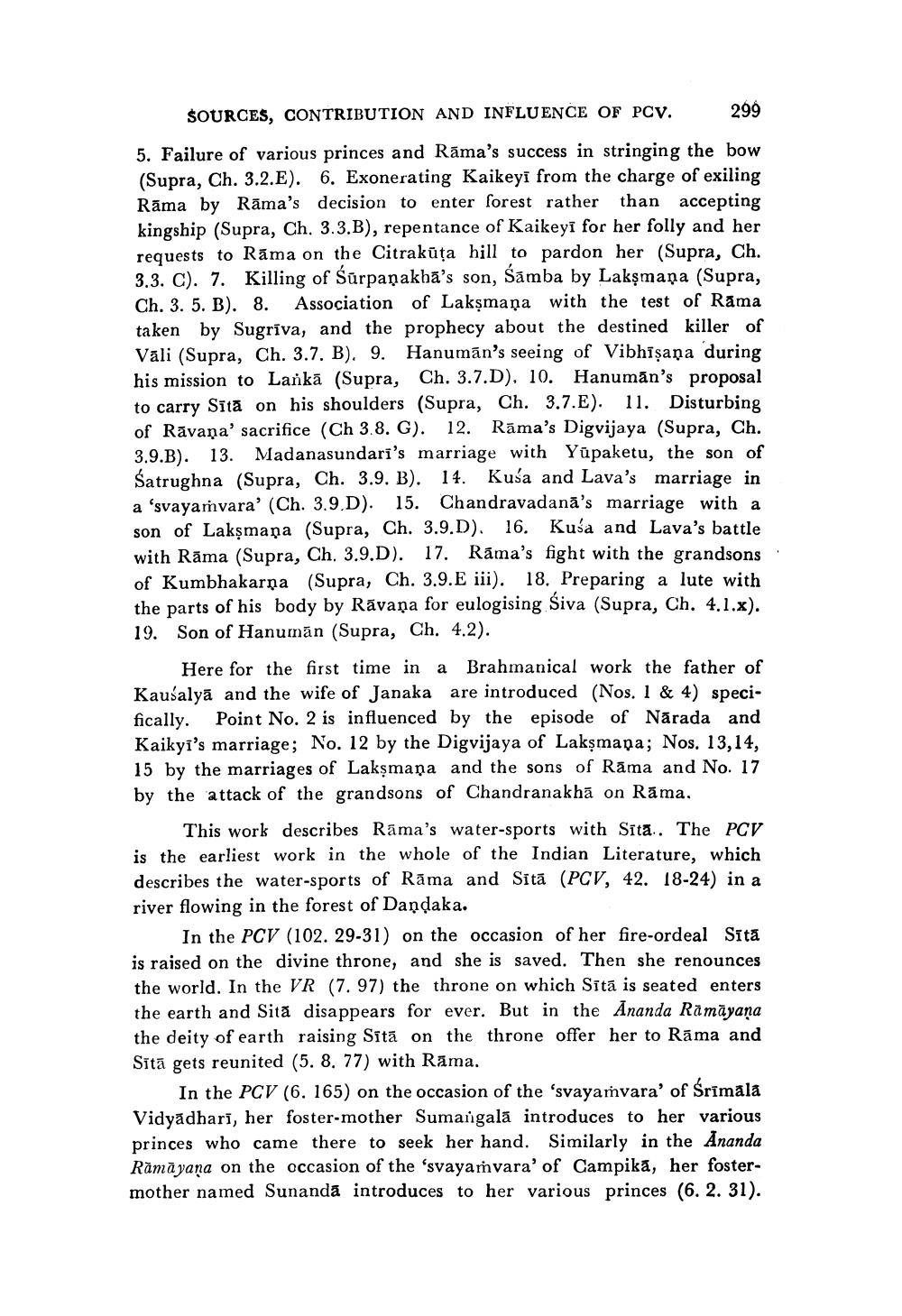________________
SOURCES, CONTRIBUTION AND INFLUENCE OF PCV.
299
5. Failure of various princes and Rāma's success in stringing the bow (Supra, Ch. 3.2.E). 6. Exonerating Kaikeyi from the charge of exiling Rāma by Rāma's decision to enter forest rather than accepting kingship (Supra, Ch. 3.3.B), repentance of Kaikeyi for her folly and her requests to Rāma on the Citrakūta hill to pardon her (Supra, Ch. 3.3. C). 7. Killing of Śūrpanakha's son, Samba by Lakşmaņa (Supra, Ch. 3. 5. B). 8. Association of Laksmana with the test of Rama taken by Sugrīva, and the prophecy about the destined killer of Vāli (Supra, Ch. 3.7. B). 9. Hanuman's seeing of Vibhīşaņa during his mission to Lankā (Supra, Ch. 3.7.D), 10. Hanuman's proposal to carry Sīta on his shoulders (Supra, Ch. 3.7.E). 11. Disturbing of Rāvana' sacrifice (Ch 3.8. G). 12. Rāma's Digvijaya (Supra, Ch. 3.9.B). 13. Madanasundari's marriage with Yūpaketu, the son of Satrughna (Supra, Ch. 3.9. B). 14. Kusa and Lava's marriage in a 'svayarivara' (Ch. 3.9.D). 15. Chandravadanā's marriage with a son of Lakşmaņa (Supra, Ch. 3.9.D). 16. Kuśa and Lava's battle with Rāma (Supra, Ch. 3.9.D). 17. Rāma's fight with the grandsons of Kumbhakarņa (Supra, Ch. 3.9. E iii). 18. Preparing a lute with the parts of his body by Rāvana for eulogising Siva (Supra, Ch. 4.1.x). 19. Son of Hanumān (Supra, Ch. 4.2).
Here for the first time in a Brahmanical work the father of Kausalyā and the wife of Janaka are introduced (Nos. 1 & 4) specifically. Point No. 2 is influenced by the episode of Närada and Kaikyi's marriage; No. 12 by the Digvijaya of Laksmana; Nos. 13,14, 15 by the marriages of Laksmana and the sons of Rāma and No. 17 by the attack of the grandsons of Chandranakhā on Rāma.
This work describes Rāma's water-sports with Sīta.. The PCV is the earliest work in the whole of the Indian Literature, which describes the water-sports of Rāma and Sitā (PCV, 42. 18-24) in a river flowing in the forest of Daņdaka.
In the PCV (102. 29-31) on the occasion of her fire-ordeal Sita is raised on the divine throne, and she is saved. Then she renounces the world. In the VR (7. 97) the throne on which Sita is seated enters the earth and Sită disappears for ever. But in the Ananda Rāmāyana the deity of earth raising Sitā on the throne offer her to Rāma and Sītā gets reunited (5. 8. 77) with Rāma.
In the PCV (6. 165) on the occasion of the 'svayamvara' of Srimala Vidyadhari, her foster-mother Sumangala introduces to her various princes who came there to seek her hand. Similarly in the Ananda Rāmāyana on the occasion of the 'svayamvara' of Campika, her fostermother named Sunanda introduces to her various princes (6. 2. 31).




